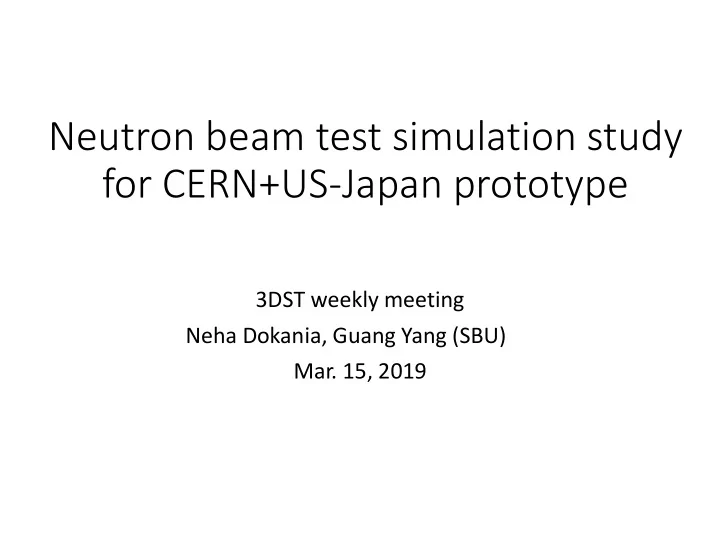

Neutron beam test simulation study for CERN+US-Japan prototype 3DST weekly meeting Neha Dokania, Guang Yang (SBU) Mar. 15, 2019
Neutron Beam Test at LANL • Proposed neutron beam test at Los Alamos National Lab (LANL) using the neutron beam (Los Alamos Neutron Science Centre facility) to be done in 2019 for the CERN + US-Japan Prototypes • Characterize the neutron response of the scintillator tracker : eg. neutron tagging efficiency, event topologies etc. Sub-ns micro pulses 1.8 μs apart within a 625 μs long macro pulse Repetition rate: up to 100 Hz Time Structure of the neutron beam at LANL 2
Simulation Studies • In the neutron beam test proposal • Neutron Tagging efficiency for different energy deposit thresholds • Deposited Neutron Energy Spectra for incident neutron kinetic energy ranges • Angular distribution of outgoing particles 3
Simulation Details • Neutron beam generated in the neutron kinetic energy range 0 - 800 MeV (power-law) and propagated through different prototype configurations using Geant4 Configuration 1 • Neutron beam directed from the US-Japan prototype side • Beam width 1 cm • Dimensions of CERN prototype : 24 x 8 x 48 cm 3 (W x H x L) and US-Japan prototype : 8 x 8 x 32 cm 3 Neutron Beam direction Geometry of the prototype configuration 1 4
Multiplicity Cube Multiplicity = No. of scintillator cubes getting hit in an event (Without any energy threshold cut for now ) • For 10 5 incident neutrons • 35% of neutrons hit two scintillator cubes • Maximum cube multiplicity is 12 5
Multiplicity vs Neutron Kinetic Energy Incident Neutron Spectra • Low Neutron Kinetic energy contributes more to hits. • Neutron beam had power-law distribution – higher statistics sample will be generated to get sufficient statistics for the high energy bins. 6
Multiplicity vs Energy Deposit • Higher Energy deposit has higher multiplicity • Higher statistics sample will be generated to get sufficient statistics 7
Configuration - 2 • Neutron beam directed from the US-Japan prototype side • Beam width 1 cm • Dimensions of CERN segment : 24 x 8 x 48 cm 3 (W x H x L) and US-Japan segment : 8 x 8 x 32 cm 3 Neutron Beam direction Geometry of the prototype configuration 2 8
Multiplicity • About 10% more events with multiplicity 1 and 2 for neutron beam incident from the US-Japan prototype side • For higher multiplicities (>2), more events are with configuration the beam from CERN prototype side 9
Summary • Neutron response to CERN+US-Japan Prototype studied for neutron beam test at LANL • Multiplicity for no. of scintillator cubes was studied for incident neutron kinetic energy as well as deposited energy in the prototypes • Neutron double tagging studies is under progress. 10
Incident Neutron Spectrum 11
Back-Up n/cm2/sec/MeV Los Alamos Neutron Science Center WNR facility provides a high flux neutron beam (scaled down by 3x10 5 ) with a broad energy spectrum similar to the cosmic-ray induced neutron spectrum at high altitude 12
Incident neutron energy spectrum Neutron Kinetic energy with zero multiplicity 13
For an incident uniform distribution Neutron Kinetic energy Neutron Kinetic energy having zero multiplicity 14
For a uniform distribution Neutron Kinetic energy 15
Neutron Tagging Efficiency = Detected neutrons / Detectable neutrons • For 10 5 incident neutrons in a uniform distribution • Energy deposit per event > Threshold value [0.1, 0.5, 1.0, 1.5 MeV] • Detectable neutrons = 76386 [neutrons which deposit any amount of energy ,i.e. no threshold cut] Neutron tagging efficiency is similar to configuration 1. • 16
Energy deposited The spectra of energy deposits for four different neutron kinetic energy ranges With the threshold cut of energy deposited per event >1.5MeV 17
Angular distribution With the threshold cut of energy deposited per event >1.5MeV 18
Recommend
More recommend